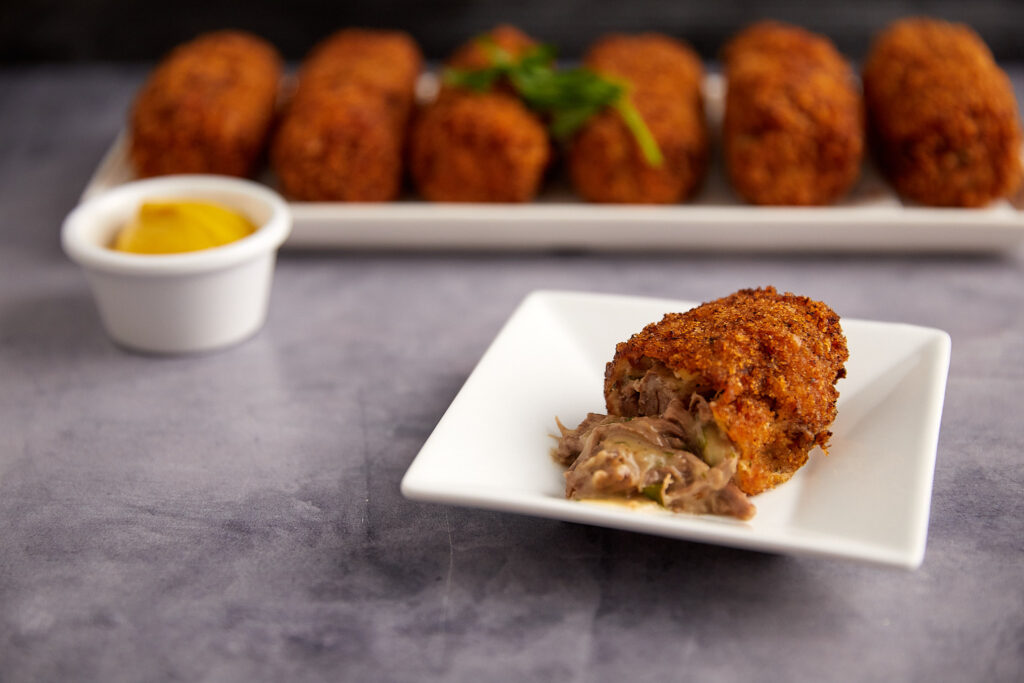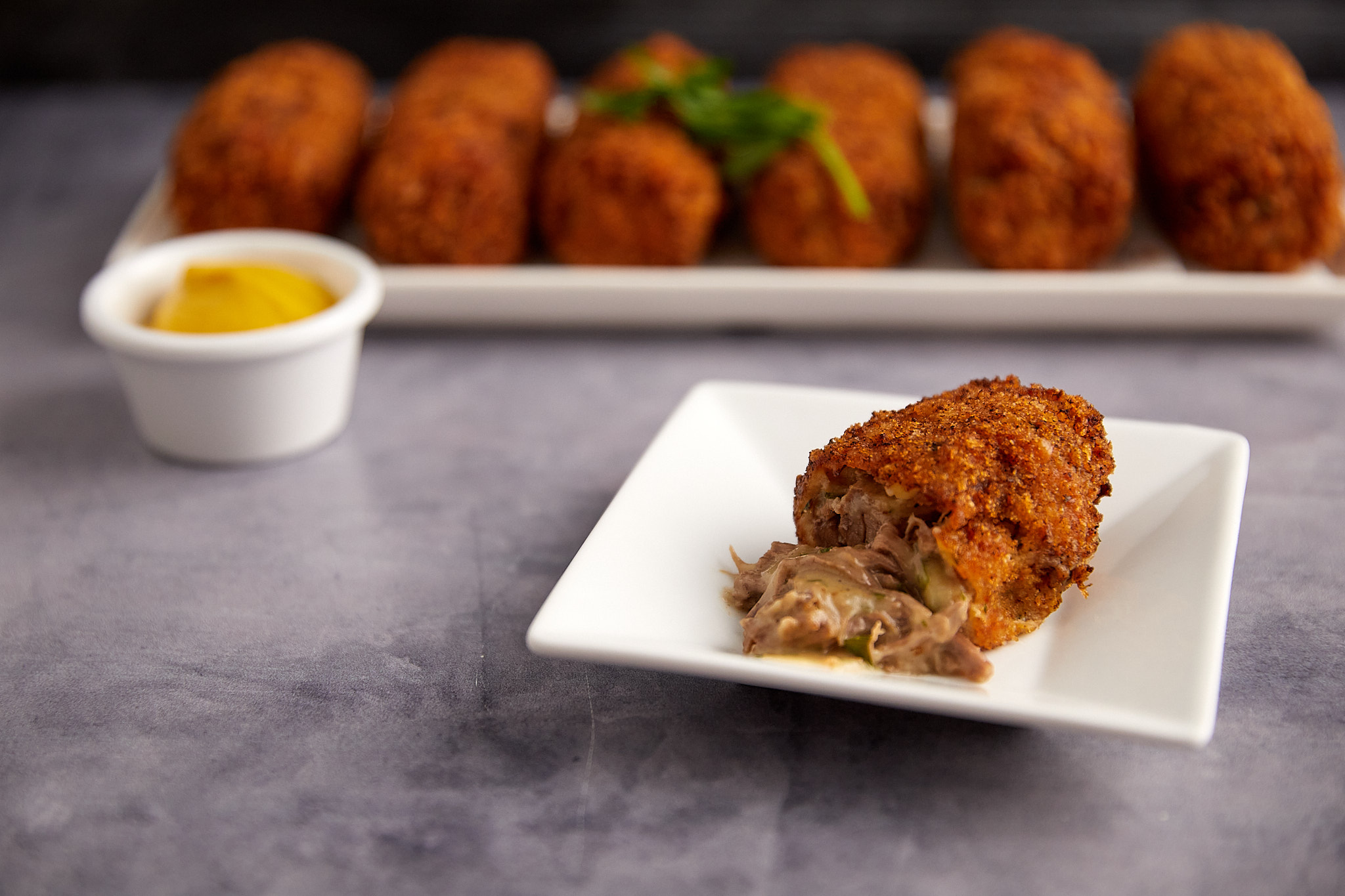Learn how to make Dutch kroketten from scratch. A Dutch beef croquette is a delicious deep-fried snack with a crunchy outside and tender meat in gravy on the inside. It is a very popular snack in The Netherlands and is either eaten by itself, or with French fries, or on a soft and fluffy bun! Fried to a golden brown color, you can find these delicious beef kroketten anywhere.
If you have ever visited the Netherlands, or you may call it Holland, you probably have eaten one of these delicious deep-fried snacks. Most likely served with some mustard and a stern warning that the insides are really really hot!
This recipe details all the steps needed to make these Dutch favorites. We start by simply making a delicious beef broth and then go on to create a traditional roux. We’ll turn that into the filling of a kroket, after which we will bread, and fry them!! To make it easy, we’ll use an Instant Pot for making the broth, so it goes a lot faster!
Kroket: Dutch Beef Croquette
Ingredients
Equipment
Method
- Cut the onion, through the root into two pieces. Make sure each half has a piece of the root attached. Remove the papery skin.
- Trim any excess fat from the brisket, and remove any silver skin.
- Add the brisket, water, parsley, bay leaves, and onion to your electric pressure cooker.Cook it at "high pressure" for1 hour.Instructions for stovetopPut your brisket, bay leaf, and water in a Dutch oven and bring to a soft boil. Once it boils, lower the flame, put the lid on your pot, and let it simmer on a low flame for 3 hours. Pay attention to the pot to make sure the water level never drops below the brisket.
- Let the pressure cooker do a natural release for at least 10 minutes, then do a quick release. (Be careful, there may still be a lot of hot steam coming out!)
- Skim any impurities off the top, and remove and discard the onion, bay leaves, and parsley.Take the beef out, and put it on a plate.
- Set your electric pressure cooker to "sautee mode," and bring the broth to a boil. Once the broth is boiling, add the bouillon cubes, and stir to dissolve.Keep cooking the broth for30 minutes, or until it's cooked down by approximately ⅓.Instructions for stovetop If your broth hasn't already reduced to approximately 2/3rd, cook it down. If it's already significantly lower, you can add some water to reach that level.
- Optionally, strain the broth through a fine-mesh strainer lined with cheesecloth, to remove solids. This makes for a nice clear broth.
- Cut the brisket into small squares, and cover it with plastic wrap.
- Put the bowl with the broth and the cut brisket in the fridge to cool down. At least 2 hours.
- When the broth and beef are almost done cooing off, it's time to start making the roux. In a large saucepan, over low heat, melt the butter.
- Once the butter is melted, still over low heat, slowly add the flour in, stirring constantly.
- Once all the flour is fully incorporated, increase the heat to medium-high, and cook it for at least 5 minutes, while constantly stirring. It should be like wet sand. If you don't cook it for 5 minutes, you'll end up tasting raw flour in the kroketten filling.
- Take the broth from the fridge, since it's time to add it to the cooked flour and butter.Set your burner to medium, and slowly add in a 250ml (1 cup) of broth. Keep stirring to make sure there are no lumps. Once it's fully combined, repeat this three more times until 1L (4 cups) of broth has been added.Keep stirring, and wait until it comes to a gentle boil. Cook this for 5 more minutes. The sauce should coat the back of a spoon, and when you run your finger through it, it shouldn't run back together. If it's too thick, you can add some water or broth.
- Add in salt, pepper, nutmeg, mustard, and vinegar, and stir well.Taste, and adjust to your liking. The vinegar and mustard should help to brighten up the sauce, but they shouldn't be recognizable flavors. There is no salt added to the beef, so keep that in mind as you taste this.
- Turn off the flame. Bloom the 2tbsp of gelatin in 120ml (½ cup) of room temperature water for 10 minutes.While the gelatin is blooming, stir the sauce from time to time; it will help it cool off, and prevent skin from forming.
- Once the gelatin is fully bloomed, and the sauce has cooled to between 48 - 60ºC (120 - 140F), add the gelatin and stir it until the gelatin is fully melted.If, for some reason, you cannot get the gelatin fully melted, put the saucepan over a really low flame, and keep stirring until it's fully melted.
- Finely chop the parsley: you'll need approximately a handful.
- Add the meat and the parsley, and stir it through the sauce.
- Pour the meat/sauce mixture into a shallow dish, and cover it with cling film directly on top of it. Put it in the fridge, and let it sit for at least 4 hours, but preferably overnight.
- Make an eggwash of the milk and eggs, and put it in a shallow dish.
- Put the breadcrumbs in a dish.
- Take out a scoop of the filling, and roll it into a log. The typical size is 10cm long, and 3cm diameter (3" long with a diameter of 1¼").
- Cover the log in breadcrumbs. Make sure you cover all sides with an even coating of breadcrumbs.
- Roll the kroket through the egg wash, shake off any excess. Roll it through the bread crumbs a second time.This double coating of bread will ensure the outside of the kroketten will be nice and crispy.
- Repeat this for the rest of the meat.
- Once all of the kroketten have been rolled, put them in the fridge for at least 2 hours.You can also freeze them now, to fry them later. If you want to do this, I recommend freezing them on a cookie sheet first, before putting them in a bag in the freezer. This way they will keep their shape, and don't stick together.
- Put your Dutch oven on the stove, and fill it with oil, making sure to not fill it more than halfway. As you add the bitterballen, the oil level will rise, and you don't want it to boil over.Heat your oil to 175C (350F). I use a Thermoworks Chef Alarm for frying. It has a clip that attaches to the pan, so the probe stays in the oil. This way I can monitor the temperature constantly.If you’re using a deep fryer, use the manufacturer’s recommended amount of oil.
- When you're ready to fry the kroketten, it's important to work in small batches, because you don't want to overcrowd the pan and lower the temperature of the oil too much. If the oil temperature drops too much, your kroketten will end up being soggy and greasy. (Keeping the batches small will also reduce the risk of having the oil boil over the edge of the pot)Line a cookie sheet with a paper towel, and put a wire rack on top of it. This is where you will put the kroketten after frying them, so any excess oil can drain off.Using a spider, carefully put 1 or 2 kroketten into the oil. Make sure they do not stick together. Cook them for approximately 5 minutes. Using the spider, take the kroketten out when they are a deep golden brown. Let any hot oil drip off over your pot or fryer before placing it on the wire rack.If any clumps of bread crumbs are floating in your oil, remove them with a spoon and allow your oil to return to 175C (350F) before you continue frying.Repeat until you've fried all the kroketten. Before serving, allow them to cool off for a few minutes because the inside will be very hot.



this is the easiest recipe I’ve ever made. Love the results. Most times I think the turn out tastier then croquettes in Holland.
Thank you Toine
Thank you, Olivia!! I am so glad to hear you enjoyed them!
I just finished making this recipe and it is soooo good!!! 10/10 recommend!!
Love this recipe, tastes just like my mother inlaws
I am dying to try this recipe. My father in law – being Dutch, used to make the most amazing kroketten. Unfortunately I do not have an electric pressure cooker but rely on an old fashioned pressure cooker on the stove top.Do you have any pointers inthis regard?
I have not used an “old-fashioned” pressure cooker, but I believe the cook time should be about the same (maybe a little bit shorter).
TOINE, I am so grateful to have stumbled upon your page. I’m a Canadian with Dutch parents and it’s been my lifelong dream to perfect Kroketten. I consider myself a very good cook but never understood the method of cooking the flour and making the broth until watching your video . They turned out perfect ! Thank you, giving myself the Dutch cooking of honour today! By the way I used a slow cooker for the meat cut of What we call pot roast here
Yvonne – thank you so much for your wonderful comment! I am so glad our recipe was able to help you make delicious kroketten!
Eet smakelijk!
I decided to learn a new dish each month & I remember this was the best thing I ate when I went to Amsterdam. Thank you for sharing … these came out good, as I remember.
I love your recipe of brisket instead of veal. No
What is a powdered gelatin in English. Is.it corn starch?
It’s called powdered gelatin and you should be able to find it in the grocery store.
I buy beef gelatin, which is a bit harder to find, but pork gelatin is readily available.
Here is a link: https://www.amazon.com/Knox-Gelatine-Unflavored-Count-Ounce/dp/B00BCMU7T4
Great and easy way to make krokketten